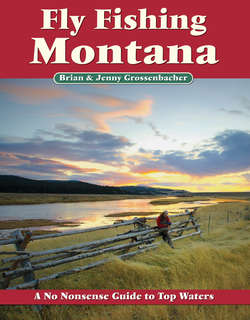Читать книгу Fly Fishing Montana - Brian Grossenbacher - Страница 14
ОглавлениеBighorn River
The Bighorn River is 112 miles in length; however, most anglers find interest in the 13-mile stretch below the Afterbay Dam (just a few miles downstream from the Yellowtail Dam) at the town of Fort Smith. Prior to 1965, the Bighorn River was warm, silty, and of little interest to trout fishermen. The completion of the Yellowtail dam, and subsequently the Afterbay dam in 1967, changed the character of the Bighorn virtually overnight by allowing the silt to settle and the water to cool in the deep water of the newly-constructed Bighorn reservoir. The portion of the river that flows through Crow Indian territory was closed to the general public in 1975. It was re-opened following a heated Supreme Court ruling that declared the river public in 1981. Public access is now available at three points on the upper 13 miles of river: Afterbay, 3 Mile (Lind Ranch) and 13 Mile (Big Horn Access).
Although the Big Horn River is a relative newcomer to the sport of flyfishing, it has comfortably settled into its role as a powerhouse tailwater trout factory. The recipe for success begins with the relative alkalinity of the water. The nutrient-rich ph borne from the limestone walls of the Bighorn Canyon creates a perfect environment for the aquatic insect population, and as go the bugs, so go the trout. Add a healthy supply of cool, clear, water and it is easy to see why the Bighorn has at times hosted up to 10,000 trout per mile, with an average size of 16"-18", in its relative short history. That being said, the Bighorn is currently enduring tough times as a result of multiple drought years in Eastern Montana. Although fish counts are down, size classes are up, and anglers still have plenty to smile about in Fort Smith.
The character of the Bighorn is spring creek in nature with flowing weed beds, undulating currents and crystal clear waters. Because the waters of the Bighorn are taken 150' below the surface of the reservoir, the Bighorn is a true year-round fishery. Although the Bighorn enjoys prolific hatches, day in and day out anglers find the most success nymph fishing. Due to its reputation as a quality tailwater fishery, the Bighorn is crowded throughout most of the year. Start early in the morning, or plan your trip during the off-season to avoid the crowds. It is important to note that during some years excessive algae can make the Bighorn difficult to fish during September and October. Call ahead before planning your fall trip to the Bighorn.
Sunset on the Bighorn. Photo by Joe Irons.
Types of Fish:
Brown and Rainbow Trout, Whitefish.
Known Hatches:
Year-round: Midges, Scuds, Sowbugs, Streamers, Craneflies, Leeches.
Mid March-Late April: Baetis.
Late April-Mid July: Caddis, Baetis.
Mid June-July: PMDs, Caddis, Ants, Beetles, Tricos, Baetis, Yellow Sallies.
August-October: Black Caddis, Hoppers, Tricos, Baetis, Streamers.
Equipment to Use:
Rods: 5-7 weight, 8½-9 feet in length.
Lines: Floating line for dries and nymphs, sink tip line for streamers.
Leaders: 12+' 4-5x for nymphs, 10' 5-7x for dries, 7' 0-2x for streamers.
Wading: Best fished by a drift boat due to the size of the river and lack of accessibility. Chest-high waders with wading belt are recommended.
Flies to Use:
Dries: Parachute Adams #16-22, BWO #18-24, Goddard's Caddis #14-18, Elk Hair Caddis #14-18, Trico #18-22, Rusty Spinner #16-20, Griffith's Gnat #18-24, Disco Midge #18-22, Cluster Midge #18-22, PMX #8-12, Parachute Hopper #6-10, Red or Black Flying Ant #16-20, Yellow Stimulator #16-18, RS-2 #18-22, Olive Sparkle Dun #16-20.
Nymphs: Brassie #18-22, Hare's Ear #16-20, Sparkle Pupa #18-20, Midge Pupa #18-22, Prince Nymph #16-18, Pheasant Tail #16-22, Lightning Bug #16-20, Serendipity #14-20, Red or Brown San Juan Worm #6-8, Pink, Orange or Olive Scud #14-20, Ray Charles #16-18, Green & Brown Bugger #2-6.
Streamers: Green, Brown, or Black Bugger #2-6, Leeches #2-8, Green, White or Natural Zonkers #2-6, JJ's Special #2-6.
When to Fish:
The Bighorn is known for being a true year-round fishery. Call ahead for conditions in late fall when the algae breaks free and makes for challenging to impossible nymph and streamer fishing. If you loathe crowds, don't bother heading in that direction in the peak summer season.
Seasons & Limits:
The standard fishing regulations for the Central and Eastern fishing districts apply. Please check the Montana Fishing Regulations and Etiquette section.
Exceptions to Standard Regulations
Afterbay Dam to Cable 600 feet downstream and downstream from Bighorn FAS
Open entire year.
May use live nongame bait fish (as identified in standard district regulations).
Combined Trout: 5 daily and in possession, only 1 over 18 inches and only 1 rainbow trout.
Cable 600 feet below Afterbay Dam to Bighorn FAS
Open entire year.
Combined Trout: 5 brown trout daily and in possession, only 1 over 18 inches. Catch-and-release for rainbow trout, except anglers 14 years of age and younger may take 1 rainbow trout daily and in possession, any size. Artificial lures only.
Nearby Fly Fishing:
Stillwater, lower Yellowstone.
Accommodations & Services:
The Bighorn Angler stakes the claim to being the oldest lodge and fly shop on the Bighorn (406-666-2233: www.bighornangler.com). Another option is Forrester's Bighorn River Resort (800-665-3799) or the Bighorn Lodge (800-235-5450: www.bighornriverlodge.com).
Rating: 9
With several thousand trout per mile, many of which are over 18", the Bighorn is a fisherman's paradise…unfortunately, the price of paradise is overcrowding.
Bighorn treasure. Photo by Brian Grossenbacher.
Another nice Bighorn brown. Photo by Joe Irons.
